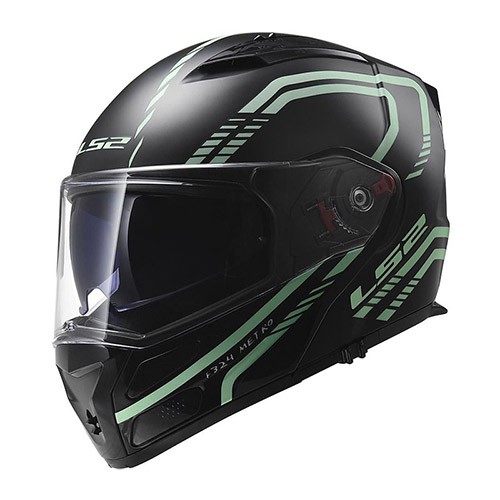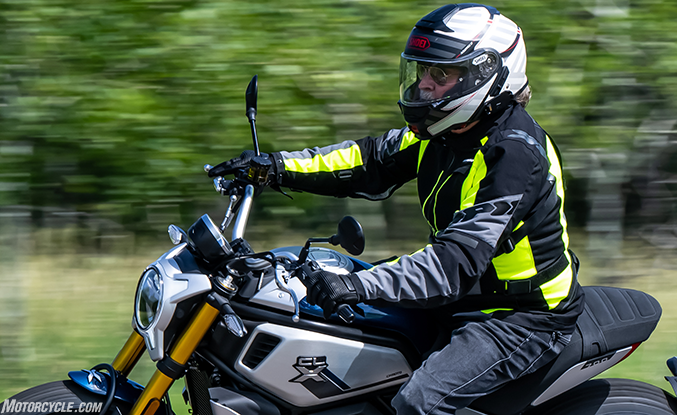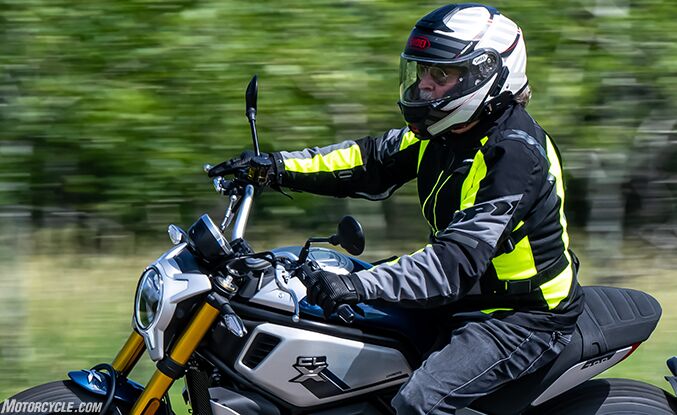
I feel like an impostor in this jacket, really. I only rode in it in the rain once, and only for about a half hour. I stayed warm and dry, but the temperature was only in the low 50s F. Plus, I was behind a nice big fairing. I really can’t speak to how it would work for you Duluthians and people who ride 80 miles to work all winter in freezing sleet on an ‘86 XR600; I can’t even relate. When I moved to SoCal, I laid down one of those Scarlett O’Hara dictums: I swear, as God is my witness, I’ll never be cold again!
A tough nylon outer shell, a removable rainproof liner, and a thermal one add up to a jacket you can ride in year-round (depending on where you’re riding).
| Aesthetics | 8.5/10 | Protection | 8/10 | Comfort | 9.25/10 |
| Value | 7.5/10 | Weight | 9.5/10 | Innovation | 9/10 |
| Quality | 9/10 | Options | 9/10 | Weather | 9.5/10 |
| Desirability | 9/10 | Editor Score: 88.25 % | |||
+ Highs
|
– Sighs
|
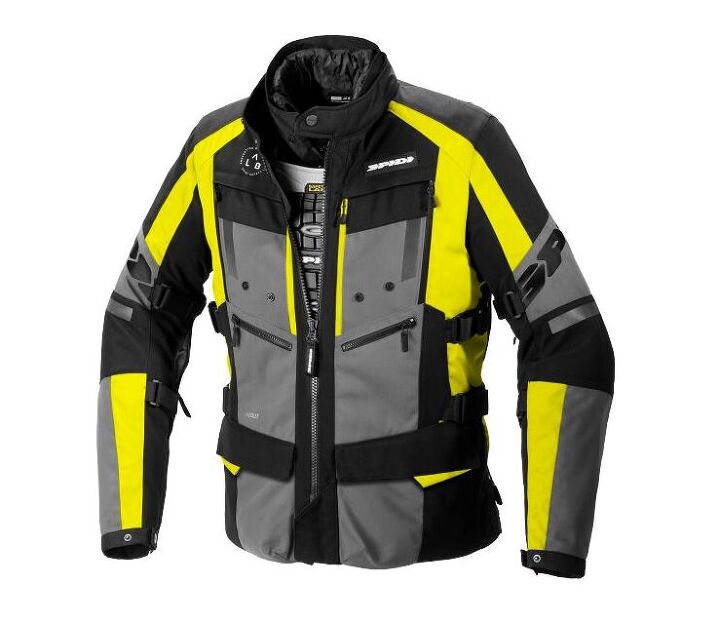 I was wrong of course., I’ve been cold and wet plenty of times in California, but seldom really freezing cold, like this time. Spidi calls this H2Out Evo the 4 Season, and I can see it, just as long as that fourth season isn’t too extreme. It’s all possible through the miracle of layers. This jacket has three of them: a “high-tenacity Extra Tenax 3-layers nylon 6.6” outer layer, a removable breathable and waterproof “2°layer H2Out lining,” and another removable, 100-grams of puffy stuff per square-meter thermal lining for warmth.
I was wrong of course., I’ve been cold and wet plenty of times in California, but seldom really freezing cold, like this time. Spidi calls this H2Out Evo the 4 Season, and I can see it, just as long as that fourth season isn’t too extreme. It’s all possible through the miracle of layers. This jacket has three of them: a “high-tenacity Extra Tenax 3-layers nylon 6.6” outer layer, a removable breathable and waterproof “2°layer H2Out lining,” and another removable, 100-grams of puffy stuff per square-meter thermal lining for warmth.
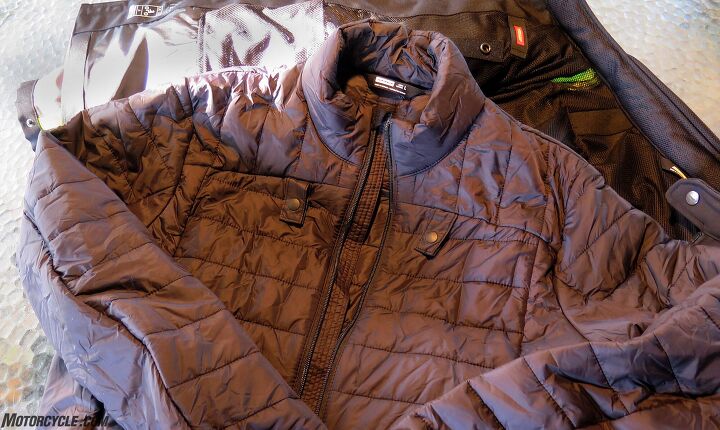
The thermal liner looks almost like my expensive Patagonia puffer… too bad there’s no handwarmer pockets though.
Variable conditions
You can wear one or both liners inside the jacket, of course, as conditions dictate. When you’re not wearing the liners, it’s easy to stick one, but not both, into the big pocket at the lower back of the jacket. On cold wet days, it makes sense to just keep the thermal liner zipped onto your body and snap the rain liner into the jacket, which you can then whip on and off as a unit.
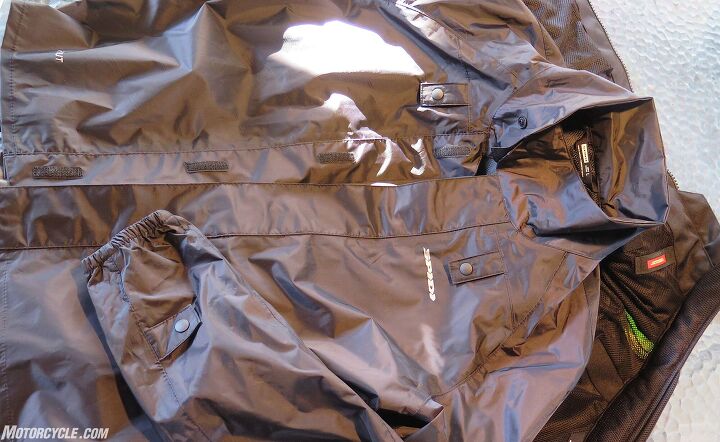
The waterproof liner goes right beneath the outer shell, natch.
On cool dry days, you might just want the shell with a sweater underneath – and the thermal liner rolled up and stashed in the back pocket in reserve. And in the summertime, you can just leave the thermal liner in the closet and the rain liner in the back pocket. There’s lots of flexibility. Also, you can wear the H2Out liner as a waterproof windbreaker by itself and look no more abnormal than usual; the thermal liner works as a puffy ski jacket by itself, too.
After my obtainment last June, though, most of the time I’ve worn the Spidi has been in the heat of summer, where it does superb work thanks to its outstanding ventilation system: The main chassis integrates high-tenacity Extra Tenax 3-layers nylon 6.6 – offering excellent abrasion and puncture resistance – and a PU coated polyester, in comfort-sensitive areas. Six generous mesh panels grant excellent air circulation; positioned on chest, forearm and back, they have been strategically located to cool the rider in the most efficient way during warmest days.
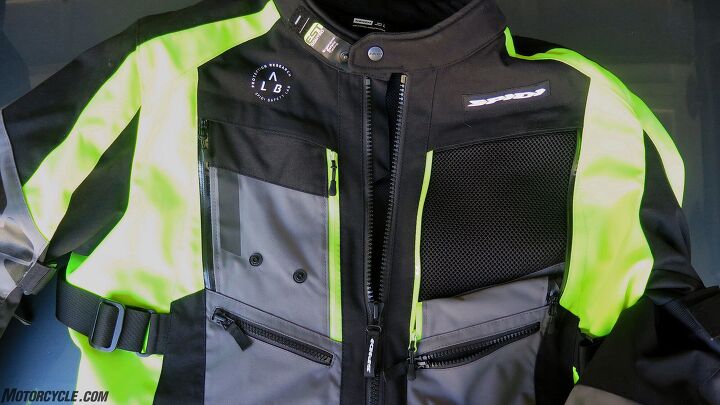
Correct. The chest panel at left is closed, the one at right is unzipped, rolled right down, and snapped out of the way via the two snaps at the bottom. Behind, there is just enough thickish nylon mesh to keep out bees and cushion gravel strikes, while letting in plenty of air. Dig also the EST collar closure: The male snap is mounted on Velcro so you can move it around to your desired snug-osity.
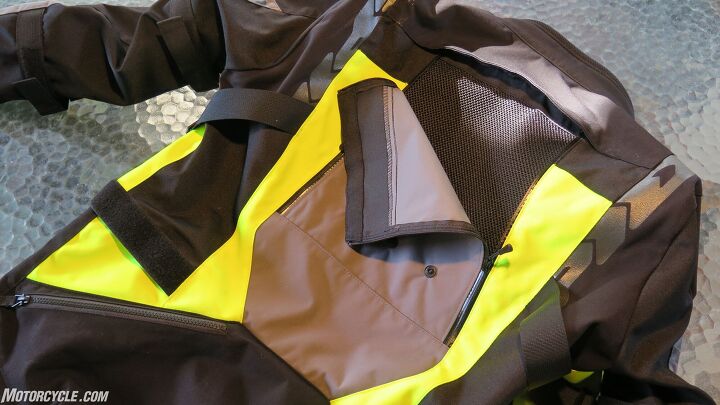
Followed up by this huge exhaust vent on back. I know what you’re thinking: What about the back protector? You don’t get one. But the Velcro attachment points for one of three Spidi back protectors are already in place, ditto for your choice of two chest protectors which attach with snaps in front – all of which are supposed to be good air circulators. Seems fair, since some people want more protection than others.
And, if you’re into things like the new Alpinestars Tech 3 airbag vest, maybe you don’t want any armor at all: My vest works much better with a textile jacket like this than a leather one, especially if you want the vest inside.
The jacket does come with ForceTech removable protectors in the shoulders, and Warrior Lite protection in the elbows – CE Level 2 certified to the EN 1621-1:2012 standard.
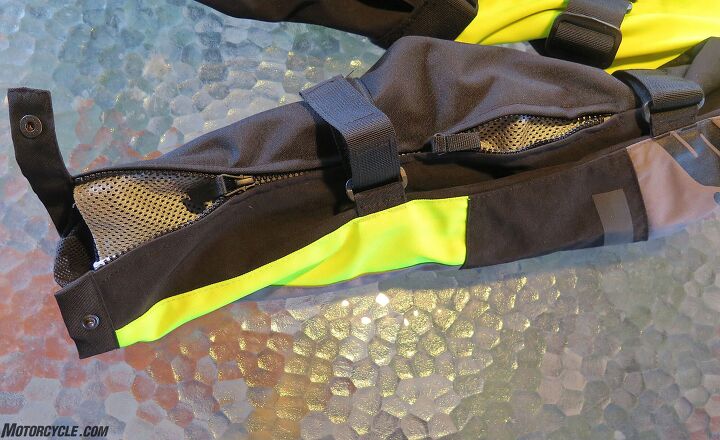
Meanwhile, your arm goes in here: The double-ended zipper and Velcro-adjustable tabs let you get the sleeves billowing with air all the way up your pits, or totally closed shut and snug. Say, is that only five vents?
There’s another pair of adjuster tabs on each side of the jacket, which allows you to loosen or snug up as needed depending on what you’ve got layered underneath or how much you’ve had to eat.
Is it safe?
For everyday street use, I feel reasonably confident rolling around with just the standard armor: The elbow armor is wide, and extends all the way down the forearm to the wrist. The shoulder armor is reasonably good too. Textile with lots of zippers is obviously not the thing for long slides on asphalt, which we all strive to avoid, but Spidi claims its “high tenacity elastic flex tenax fabric” provides extreme abrasion resistance. Safety-per-pound wise, the light weight and comfort of the Spidi compared to a leather jacket means you’re way more likely to be wearing it even on the hottest days. I like that there’s enough hi-viz yellow to make you POP, but not so much to make you ill. Many of the panels out back are reflective. And there are black and red/black color options, too, for those who prefer stealth over deterrence.
In addition to that, I see no reason why this Spidi couldn’t be a great adventure jacket, especially with the optional chest and back armor.
Storage
There’s quite a bit, and one significant upgrade in the Evo is that its two big lower front pockets are now waterproof.
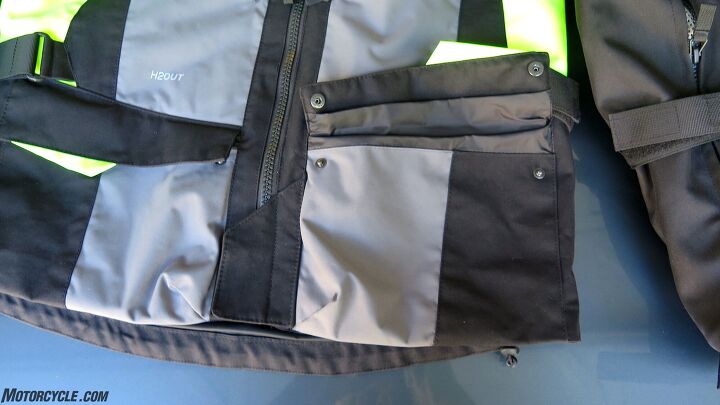
There are two more non-WP smaller zippered pockets above them, along with the big zippered pocket astern. When they’re zipped closed, the big air vents can also act as pockets. There’s also now a zipper to connect the jacket to Spidi’s matching Evo pants. Which I haven’t got.
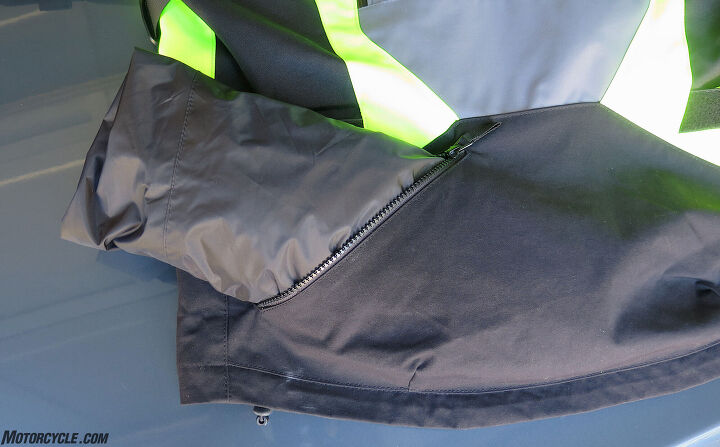
You can carry the H2Out liner and a big bottle of agua back there pretty easily, but I couldn’t stuff both liners in at the same time.
In the mesh lining inside, which also promotes air circulation, there’s a big, 9- x 5-inch pocket on the right front down low, and a zippered left breast pocket.
Will it last?
My other at least 10-year old Spidi jacket like this one most recently made an appearance in last week’s Christmas Chiselers Tour, and is still going strong. It’s quality stuff and holding up well – and I even like the old one’s suede panels better, but the Evo’s new features and more storage has it all over the older one. At $579, you expect and deserve quality. Oh hey, looka that: It’s on Closeout sale…
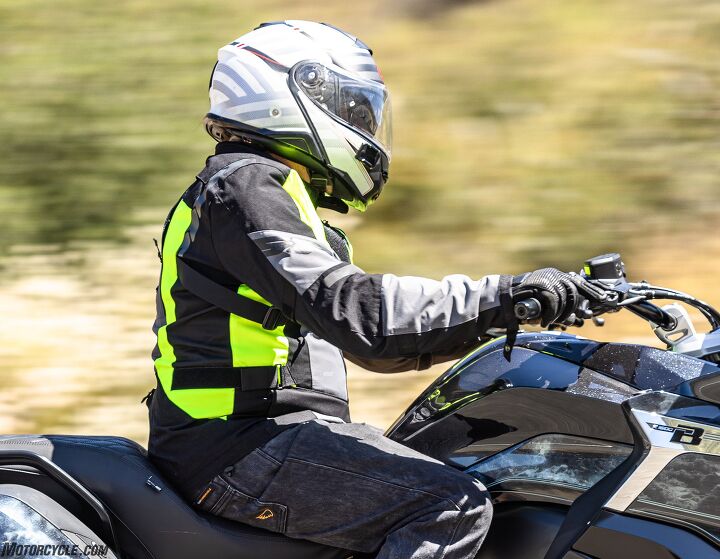
The stuff in this photo costs more than MO pays me in a year. Good thing I’m a chiseler…
Shop for the Spidi 4 Season H2Out here
FAQ
Is a textile jacket as safe as a leather one?
It’s entirely dependent on the nature of your crash. Racers wear leathers on race tracks for its greater abrasion resistance when sliding at high speed. Long slides are far less common in street or ADV crashes, where the bigger danger usually involves impacting things at lower speeds, like curbs or trees or rocks. For that, the best defense is good armor. Most textile jackets like this Spidi come with basic elbow and shoulder armor; the best ones offer optional back and chest protectors, also like this Spidi. Then there’s the high visibility and reflectivity of this Spidi versus basic black leather.
Which is more comfortable?
Leather is the traditional garb of course, and can be really flexible and light. But the safest leather jackets tend to be heavier and stiffer. Textile is always going to be lighter, easier to sew and add features to, and that gives a nylon jacket like this Spidi the advantage in terms of comfort, everyday wearability and all-weather flexibility. Its sizing adjustments also let it expand enough to fit an air vest or jacket underneath.
Where does Spidi gear come from?
It’s designed in Italy, and this jacket is manufactured in Vietnam.
Additional Resources
Best Textile Motorcycle Jackets
One Kit to Do It All: Best 4-Season Motorcycle Jackets
MO Tested: Spidi 4 Season H2Out Suit Review
We are committed to finding, researching, and recommending the best products. We earn commissions from purchases you make using the retail links in our product reviews. Learn more about how this works.
Become a Motorcycle.com insider. Get the latest motorcycle news first by subscribing to our newsletter here.
